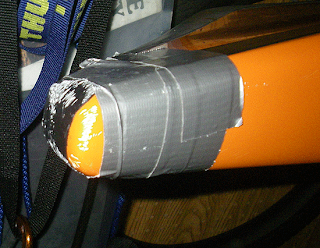A Medical Case Study
Successful Scientific Approach
Of a Rare Nautical Congenital Lesion
Utilizing
The Team Method
History
This pediatric patient, of English birth, was only a few months old when it developed leakage problems in the area of the lower bowels. The patient's delivery was professional and without complications and there was nothing on examination (early on) to suggest any congenital problems. Records confirm that the post natal care was excellent.
Because of the chronic nature of the problem that developed, the patient was referred to a highly respected team of specialists that included JB, a highly rated POF (Professor of Kayaking) and an EMT; Sherri, a highly rated POF with a long experience in the anatomy of these patients, and yours truly.
Proceedure
The patient was prepared and draped in the normal manner and its rear umbilical cord (here after referred to as the toggle) was removed without complications. Then, purposely omitting any anesthetic which might blunt the response, SADT (specially adapted duct tape) was applied in the coronal plane circumventing the dorsal/distal end of the patient (see phot below...used with patient's permission).
Next, according to the protecal demanded in the grant, the patient was taken to the diagnostic tank test and subjected to the AAR test (all sorts of rolls) after which the patient was taken back to the lab for final testing.Findings
After excissing the circumference of the the distal cavity (here after known as the rear hatch), it was noted that no extra or intracellular fluids had entered this area. This was carefully confirmed after which the area was recovered. The sponge count (1) was noted to be correct.
Conclusion
Many of you, because you practice (your sport) in small and remote areas, do not have access to large diagnostic centers with sophisticated instruments and techniques as described in this paper. Suffice to say, the patient does, in fact, have a small congential lesion; that being PTO/WR or a patent toggle opening with regurgitation (also called insufficiency in some literature).
Therapeautic Plan
The patient will be referred back to the author's garage where plastic surgery involving well tested chemicals will be used to close the offending lesion. In most of these cases, the proceedure takes less than an hour, is well established and is approved by the AMA, BCU and ACA. There is often a slight febrile/thermal reaction, but this is self limited and does not usually require medication. Best of all, with this modern technique the patient often can return to work the very next day. Some researchers are already reporting cases of patients treated early in the morning and actually working that same day.
Prognosis
If the author does not breath in too much of the toxic fumes there is chance of total recovery.
Paddle safe...
DS









18 comments:
in "laymans terms": your Cetus developed a leak... where exactly?
In the pic you show the very stern taped up; is it there where the leak occured? any particular reason? like fabric/gel coat bubble?
Gnarlydog wants to know coz one of his beloved "patients" also had some "skin infections" :-)
Diagnosis? A fistula. Apparently the end pour didn't entirely seal the passage through which the toggle line is threaded. I will put a straw or dowel in the hole and pour some resin around it to see if it seals. If not, I may need a small end pour.
I am concerned that disclosure of this information may be an infraction of HPPA laws.:)
Excellent case study, Doctor - might I inquire if a thorough review of the literature has been done, with particular emphasis on the incidence of such congenital lesions (either in first-degree relatives of said patient or those hailing from similar geographic areas)?
:-)
would not use a dowel as the resin will adhere to it and then you have another stick in your boat (besides your GP). Personally, I'm not sure that the lesser invasive measure of approaching the fistula repair from the external opening at the toggle orfice will provide successful results. I'd go for the more reliable repair by the ingestion of resin through the larger orfice of the rear hatch opening (do the end pour). jb PoK
Sherri: I should have mentioned that proper patient releases were obtained and are on the chart.
Susan: Although rare, these cases do occur. Thankfully it is carried on a recessive gene and is seen most often when the parents are first cousins.
JB: Good point. We are checking to see what Mr. Cetus' insurance will cover.
With all the documentation, and the receipts from these fine medical consultants, T-19 should cover this procedure. And, if you need ambulance transport you know who to call.
T19, indeed. This boat works hard and is not on the dole.
Unless it already has insurance, in all likelihood this proceedure won't be covered as it is a "pre-existing condition". So, unless it is of age to covered under Medicare, or is service related--in which case perhaps the VA will come through, after years of arguing and appeals, and the same with SSI, it will be a "self-pay".
Great...I'll get stuck with the bill.
do you take referrals
Hold referrals until we see if this patient makes it :)
One of my kayaks did not come with end grab handles.
I had to make my own ones.
Since the bow and stern did not have an end pour I just drilled a hole on the seam and inserted a section of anodized aluminum tube (I used a section of a backpacking tent pole but other non corrosive tubes can be used as long as they stick to epoxy).
The tube was to the exact width of the hole. Some epoxy was used to secure the tube to the fiberglass. After a year it is still holding well and no leaks.
I recall watching a colleague of mine repair such a fistula (created by a failed insertion of a dorsal appendage -> carry handle) combined with the creation of a transverse ostomy sealed with a pretty nifty end pour. Picture 18' of kayak on end against a birch tree with a very tall man, head in the forward hatch, pouring resin into the bow at the end of his (considerable!) reach. He was a wee bit wobbly by the end of it all!!
Love the blog - for the sake of the readers, let the silliness continue!
Susan, your comments were so stimulating that I broke scrub to join in. You have raised the yeet unspoken topic of the part of the anesthesiology sciences in this proceedure. Although the Cetus is not "put under" (a serious problem for any kayak), the aromatic fumes produced by the replacement therapy can be fatal to the operator. A recent totally blind study in the Annals of Kayak Repair has found that preop hyperventilation followed by holding of the breath during the pour avoids this very complication. Finally, let me compliment you on your academic description of the extreme Fowler's position the patient needs to be in to be sure the applied ointments go to the distal pelvic area. Carry on.
(this is beginning to get very silly - how fun!)
Thank you for your kind comments - one small correction. As it was a cephalad pour, the patient was placed in maximal Trendelenberg. Same spirit, though!
;-)
Point well taken, Susan. I was thinking of my pt. The one you described would of course be reversed. What we basically have here is similar to the subtle difference between an angiogram of the brain and an enema.
Ba ha ha ha ha ha (still laughing!)
Post a Comment